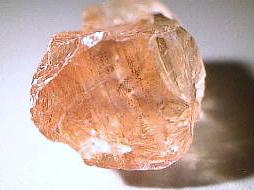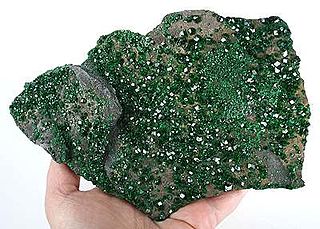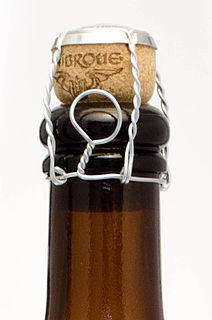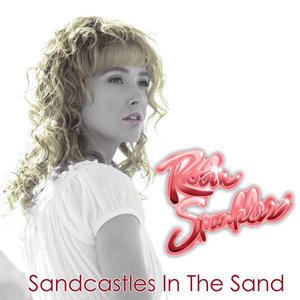
A gemstone is a piece of mineral crystal which, in cut and polished form, is used to make jewelry or other adornments. However, certain rocks and occasionally organic materials that are not minerals are also used for jewelry and are therefore often considered to be gemstones as well. Most gemstones are hard, but some soft minerals are used in jewelry because of their luster or other physical properties that have aesthetic value. Rarity and notoriety are other characteristics that lend value to gemstones.

Topaz ( TOH-paz) is a silicate mineral of aluminium and fluorine with the chemical formula Al2SiO4(F, OH)2. It is used as a gemstone in jewelry and other adornments. Common topaz in its natural state is colorless, though trace element impurities can make it pale blue, golden brown to yellow orange. Topaz is often treated with heat, or radiation to make it a deep blue, reddish-orange, pale green, pink, or purple.

A ruby is a pink to blood-red colored gemstone, a variety of the mineral corundum. Ruby is one of the most popular traditional jewelry gems and is very durable. Other varieties of gem-quality corundum are called sapphires. Ruby is one of the traditional cardinal gems, alongside amethyst, sapphire, emerald, and diamond. The word ruby comes from ruber, Latin for red. The color of a ruby is due to the element chromium.

A wine bottle is a bottle, generally a glass bottle, that is used for holding wine. Some wines are fermented in the bottle while others are bottled only after fermentation. Recently the bottle has become a standard unit of volume to describe sales in the wine industry, measuring 750 millilitres. Wine bottles are produced, however, in a variety of volumes and shapes.
Chlorastrolite, also known as Isle Royale Greenstone, is a green or bluish green stone. Chlorastrolite has finely radiating or stellate masses that have a "turtleback" pattern. The stellate masses tend to be chatoyant, meaning they have a varying luster. This chatoyancy can be subtranslucent to opaque. Cholorastrolite is a variety of pumpellyite: Ca
2(Mg,Fe)Al
2(SiO
4)(Si
2O
7)•(OH)
2H
2O. Chlorastrolite was once thought to be an impure variety of prehnite or thomsonite.

Kaito Kuroba, the true identity of the gentleman thief "Kaito Kid", is a fictional character and protagonist of the Magic Kaito manga series created by Gosho Aoyama. His father Toichi Kuroba was the original Kaito Kid before being killed by an unknown organization, while his mother was a former phantom thief known as the Phantom Lady. Kaito Kuroba then takes on the role of Kid after learning the organization is after a gemstone called Pandora and decides to find and destroy it.

Sunstone is a plagioclase feldspar, which when viewed from certain directions exhibits a spangled appearance. It has been found in Southern Norway, Sweden, various United States localities and on some beaches along the midcoast of South Australia.
Sweet Secrets was a toy introduced by Galoob in 1984 which transformed from jewelry, makeup and other girl-oriented objects to animals, girls with hair, and playsets. This was done by opening the object and unfolding the head, arms, and legs. The playsets included a jewelry box which transformed into a dollhouse, a play phone which transformed into a nursery, a comb which transformed into a bed, and a photo frame which transformed into a pool. In Fall 2007, Play Along Toys re-released the Sweet Secrets series; but instead of charms, they were tiny dolls that could fit into lipstick tubes and change purses.
Metallised films are polymer films coated with a thin layer of metal, usually aluminium. They offer the glossy metallic appearance of an aluminium foil at a reduced weight and cost. Metallised films are widely used for decorative purposes and food packaging, and also for specialty applications including insulation and electronics.
Georg Friedrich Strass was an Alsatian jeweler and inventor of imitation gemstones. He is best known as the inventor of the rhinestone, called strass in many European languages, from a particular type of crystal he found in the river Rhine.
Foil opals are simulated opal gemstones that first came into vogue during the jewelry-making boom of the late-Victorian era. Across Europe and the United States, these faux gemstones joined their paste counterparts as the need for jewelry outstripped both gemstone availability and nouveau middle-class budgets. The term 'foil' refers to an actual metal foil that was sometimes used to create reflection and sparkle behind milky glass or quartz faces. Though technically incorrect, other simulated opals with various types of sparkling inclusions or shiny backings are sometimes also referred to as 'foil opals' by jewelry collectors.
Gary Lord is a Cincinnati, Ohio-based faux painting artist and teacher. He owns a decorative painting business, Gary Lord Wall Options and Associates Inc, and is the founder of Prismatic Painting Studio and ItsFauxEasy.com, a video-based faux painting teaching site. He has been teaching faux painting techniques for over 25 years via seminars, DVDs, the Internet, and best-selling books. He has also appeared on hundreds of television segments demonstrating faux painting and decorating techniques. From 2002 - 2013 Gary's work has won a total of nine National 1st Place Awards for Best Faux Finisher of the Year by the Painting and Decorating Contractors of America and by the American Painting Contractor. He also was named to the top spot by American Painting Contractor for Who's Who in Decorative Painting in America in 2007.
Kundan is a traditional form of Indian gemstone jewellery involving a gem set with a gold foil between the stones and its mount, usually for elaborate necklaces. The method is believed to have originated in the royal courts of Rajasthan and Gujarat. It is one of the older forms of jewellery made and worn in India. The word kundan means highly refined gold, and a highly refined and pure form of molten gold is used.

Marcasite jewelry is jewelry made using cut and polished pieces of pyrite as gemstone, and not, as the name suggests, from marcasite.
ImaGem Inc. is a gem information company based on patented technology for grading and identifying gems. The parent company, ImageStatistics, offers applications in imaging and image processing for the medical, pharmaceutical, manufacturing, chemical and quality assurance industries. ImaGem was created after 20 years of research done on human perception and ImageStatistics, a statistical tool developed by Dr. Lalit K. Aggarwal. ImaGem’s Systems employ advanced optics, imaging technology and proprietary software programs to automate and integrate diamond grading. In addition to evaluating the 4C’s of diamond grading, ImaGem also analyzes Light behavior information based on precise and repeatable measures; three complementary dimensions of brilliance, intensity and sparkle. ImaGem has created a system of uniquely identifying and registering (fingerprinting) a stone without any need for laser inscription. By offering all this information, ImaGem has promoted decision-making and efficiency in the gem industry supply chain. In 1998, ImaGem Inc. was incorporated in the state of Pennsylvania, USA after funding from a major retailer, Ben Franklin Technology Partnership, and private funding. The company has developed an integrated technology to collect image data for diamonds and gemstones, analyze it using direct measurement methodology and grade for precise and repeatable measurements.

In geology, druse refers to a coating of fine crystals on a rock fracture surface or vein or within a vug or geode.

Sparkle is a 2012 American musical film directed by Salim Akil and produced by Stage 6 Films, It was released on August 17, 2012, by TriStar Pictures. Inspired by The Supremes, Sparkle is a remake of the 1976 film of the same title, which centered on three singing teenage sisters from Harlem who form a girl group in the late 1950s. The remake takes place in Detroit, Michigan in 1968 during the Motown era.

"Let's Go to the Mall" is a song written by Craig Thomas and Carter Bays for the CBS television series How I Met Your Mother. The song was performed by Canadian actress Cobie Smulders in the role of Robin Scherbatsky, who has a secret past of being a teenage Canadian pop star and adopted the stage name Robin Sparkles. Thomas and Bays originally came up with the idea and spent weeks developing the story with writer Kourtney Kang. The song was first featured in the form of a faux music video in the episode "Slap Bet" that aired on November 20, 2006, before the song was digitally released as a single on September 4, 2007. The track later appeared on the soundtrack album How I Met Your Music (2012).

A muselet is a wire cage that fits over the cork of a bottle of champagne, sparkling wine or beer to prevent the cork from emerging under the pressure of the carbonated contents. It derives its name from the French museler, to muzzle. The muselet often has a metal cap incorporated in the design which may show the drink maker's emblem. They are normally covered by a metal foil envelope. Muselets are also known as wirehoods or Champagne wires.

"Sandcastles in the Sand" is a song written by Craig Thomas and Carter Bays for the CBS television series How I Met Your Mother. The song was performed by Canadian actress Cobie Smulders in the role of Robin Scherbatsky, who has a secret past as a teenage Canadian pop star under the stage name Robin Sparkles. A follow-up to "Let's Go to the Mall" (2006), "Sandcastles in the Sand" was inspired by several 1980s pop ballads. The song was made available for streaming on April 15, 2008, before it appeared in an episode of the same name that aired on April 21. It was released as a single on April 23, and appeared on the soundtrack album How I Met Your Music (2012).











